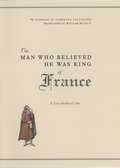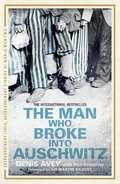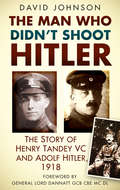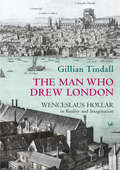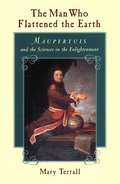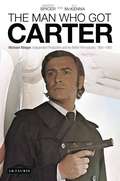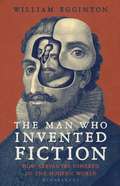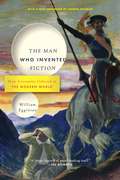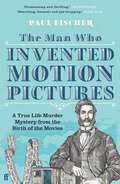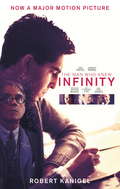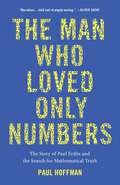- Table View
- List View
The Man Who Ate His Boots: Sir John Franklin and the Tragic History of the Northwest Passage
by Anthony BrandtDozens of missions set out for the Arctic during the first half of the nineteenth century; all ended in failure and many in disaster, as men found themselves starving to death in the freezing wilderness, sometimes with nothing left to eat but their companions' remains. Anthony Brandt traces the complete history of this noble and foolhardy obsession, which originated during the sixteenth century, bringing vividly to life this record of courage and incompetence, privation and endurance, heroics and tragedy. Along the way he introduces us to an expansive cast of fascination characters: seamen and landlubbers, scientists and politicians, sceptics and tireless believers.The Man Who Ate His Boots is a rich and engaging work of narrative history - a multifaceted portrait of noble adventure and of imperialistic folly.
The Man Who Believed He Was King of France: A True Medieval Tale
by Tommaso di Carpegna FalconieriReplete with shady merchants, scoundrels, hungry mercenaries, scheming nobles, and maneuvering cardinals, The Man Who Believed He Was King of France proves the adage that truth is often stranger than fiction—or at least as entertaining. The setting of this improbable but beguiling tale is 1354 and the Hundred Years’ War being waged for control of France. Seeing an opportunity for political and material gain, the demagogic dictator of Rome tells Giannino di Guccio that he is in fact the lost heir to Louis X, allegedly switched at birth with the son of a Tuscan merchant. Once convinced of his birthright, Giannino claims for himself the name Jean I, king of France, and sets out on a brave—if ultimately ruinous—quest that leads him across Europe to prove his identity. With the skill of a crime scene detective, Tommaso di Carpegna Falconieri digs up evidence in the historical record to follow the story of a life so incredible that it was long considered a literary invention of the Italian Renaissance. From Italy to Hungry, then through Germany and France, the would-be king’s unique combination of guile and earnestness seems to command the aid of lords and soldiers, the indulgence of inn-keepers and merchants, and the collusion of priests and rogues along the way. The apparent absurdity of the tale allows Carpegna Falconieri to analyze late-medieval society, exploring questions of essence and appearance, being and belief, at a time when the divine right of kings confronted the rise of mercantile culture. Giannino’s life represents a moment in which truth, lies, history, and memory combine to make us wonder where reality leaves off and fiction begins.
The Man Who Believed He Was King of France: A True Medieval Tale
by Tommaso di Carpegna FalconieriReplete with shady merchants, scoundrels, hungry mercenaries, scheming nobles, and maneuvering cardinals, The Man Who Believed He Was King of France proves the adage that truth is often stranger than fiction—or at least as entertaining. The setting of this improbable but beguiling tale is 1354 and the Hundred Years’ War being waged for control of France. Seeing an opportunity for political and material gain, the demagogic dictator of Rome tells Giannino di Guccio that he is in fact the lost heir to Louis X, allegedly switched at birth with the son of a Tuscan merchant. Once convinced of his birthright, Giannino claims for himself the name Jean I, king of France, and sets out on a brave—if ultimately ruinous—quest that leads him across Europe to prove his identity. With the skill of a crime scene detective, Tommaso di Carpegna Falconieri digs up evidence in the historical record to follow the story of a life so incredible that it was long considered a literary invention of the Italian Renaissance. From Italy to Hungry, then through Germany and France, the would-be king’s unique combination of guile and earnestness seems to command the aid of lords and soldiers, the indulgence of inn-keepers and merchants, and the collusion of priests and rogues along the way. The apparent absurdity of the tale allows Carpegna Falconieri to analyze late-medieval society, exploring questions of essence and appearance, being and belief, at a time when the divine right of kings confronted the rise of mercantile culture. Giannino’s life represents a moment in which truth, lies, history, and memory combine to make us wonder where reality leaves off and fiction begins.
The Man Who Broke into Auschwitz: The Extraordinary True Story (Extraordinary Lives, Extraordinary Stories of World War Two)
by Denis Avey Rob BroombyTHE INTERNATIONAL BESTSELLERTHE MAN WHO BROKE INTO AUSCHWITZ is the extraordinary true story of a British soldier who marched willingly into Buna-Monowitz, the concentration camp known as Auschwitz III.In the summer of 1944, Denis Avey was being held in a POW labour camp, E715, near Auschwitz III. He had heard of the brutality meted out to the prisoners there and he was determined to witness what he could. He hatched a plan to swap places with a Jewish inmate and smuggled himself into his sector of the camp. He spent the night there on two occasions and experienced at first-hand the cruelty of a place where slave workers, had been sentenced to death through labour. Astonishingly, he survived to witness the aftermath of the Death March where thousands of prisoners were murdered by the Nazis as the Soviet Army advanced. After his own long trek right across central Europe he was repatriated to Britain. For decades he couldn't bring himself to revisit the past, but now Denis Avey feels able to tell the full story - a tale as gripping as it is moving - which offers us a unique insight into the mind of an ordinary man whose moral and physical courage are almost beyond belief.
The Man Who Broke Napoleon's Codes: The Story of George Scovell
by Mark UrbanIn 1812 two mighty armies manoeuvred across the Spanish plains. They were finely balanced, under skilful leaders. Each struggled to gain an advantage. Wellington knew that if he defeated the French, he could turn the tide of the war. Good intelligence was paramount, but the French were using a code of unrivalled complexity - the 'Great Paris Cipher'. It was an unprecedented challenge, and Wellington looked to one man to break the code: Major George Scovell. Using a network of Spanish guerrillas, Scovell amassed a stack of coded French messages, and set to work decrypting them. As a man of low birth, Scovell - even with his genius for languages, and bravery on a dozen battlefields - struggled for advancement amongst Wellington's inner circle of wealthier, better connected officers. Mark Urban draws on a wealth of original sources, including many cyphers and code-tables, to restore Scovell to his rightful place in history as the man who was the brains behind the intelligence battle against Napoleon's army and a forerunner of the great code-breakers of the 20th Century.
The Man Who Created the Middle East: The Life Of Sir Mark Sykes
by Christopher Simon SykesAt the age of only 36, Sir Mark Sykes was signatory to the Sykes-Picot agreement, one of the most reviled treaties of modern times. A century later, Christopher Sykes’ lively biography of his grandfather reassesses his life and work, and the political instability and violence in the Middle East attributed to it.
The Man Who Didn’t Shoot Hitler: The Story of Henry Tandey VC and Adolf Hitler, 1918
by David JohnsonThis is the tale of two men.The first is Henry Tandey, an ordinary man later deemed to be ‘a hero of the old berserk type’, born and brought up in Leamington Spa, Warwickshire, who displayed extraordinary courage to emerge from the First World War as the most decorated British private to survive. The second is Adolf Hitler, who was highly decorated in his service to Germany in the First World War and went on to become one of the most infamous dictators in history, later bringing the world to the brink of destruction during the Second World War. It seems unlikely that their fates should collide. Yet in 1938 Hitler named Tandey as the soldier who spared his life on 28 September 1918 in the aftermath of the Battle of Marcoing – an assertion that came as a surprise to Tandey himself. The Man Who Didn’t Shoot Hitler tells the story of Tandey’s and Hitler’s Great War, the moment when their lives became intertwined – if in fact they did – and how Tandey lived with the stigma of being known not for his chestful of medals for gallantry in service of King and Country, but as the man who let Hitler live.
The Man Who Drew London: Wenceslaus Hollar In Reality And Imagination
by Gillian TindallThe seventeenth-century London Wenceslaus Hollar knew is now largely destroyed or buried. Yet its populous river, its timbered streets, fashionable ladies, old St Paul's, the devestation of the Fire, the palace of Whitehall and the meadows of Islington live on for us in his etchings.Drawing on numerous sources, Gillian Tindall creates a montage of Hollar's life and times and of the illustrious lives that touched his. It is a carefully researched factual account, but she has also employed her novelist's skill to form an intricate whole - a life's texture which is also an absorbing and occasionally tragic story.
The Man Who Flattened the Earth: Maupertuis and the Sciences in the Enlightenment
by Mary TerrallSelf-styled adventurer, literary wit, philosopher, and statesman of science, Pierre-Louis Moreau de Maupertuis (1698-1759) stood at the center of Enlightenment science and culture. Offering an elegant and accessible portrait of this remarkable man, Mary Terrall uses the story of Maupertuis's life, self-fashioning, and scientific works to explore what it meant to do science and to be a man of science in eighteenth-century Europe. Beginning his scientific career as a mathematician in Paris, Maupertuis entered the public eye with a much-discussed expedition to Lapland, which confirmed Newton's calculation that the earth was flattened at the poles. He also made significant, and often intentionally controversial, contributions to physics, life science, navigation, astronomy, and metaphysics. Called to Berlin by Frederick the Great, Maupertuis moved to Prussia to preside over the Academy of Sciences there. Equally at home in salons, cafés, scientific academies, and royal courts, Maupertuis used his social connections and his printed works to enhance a carefully constructed reputation as both a man of letters and a man of science. His social and institutional affiliations, in turn, affected how Maupertuis formulated his ideas, how he presented them to his contemporaries, and the reactions they provoked. Terrall not only illuminates the life and work of a colorful and important Enlightenment figure, but also uses his story to delve into many wider issues, including the development of scientific institutions, the impact of print culture on science, and the interactions of science and government. Smart and highly readable, Maupertuis will appeal to anyone interested in eighteenth-century science and culture. “Terrall’s work is scholarship in the best sense. Her explanations of arcane 18th-century French physics, mathematics, astronomy, and biology are among the most lucid available in any language.”—Virginia Dawson, American Historical Review Winner of the 2003 Pfizer Award from the History of Science Society
The Man Who Flattened the Earth: Maupertuis and the Sciences in the Enlightenment
by Mary TerrallSelf-styled adventurer, literary wit, philosopher, and statesman of science, Pierre-Louis Moreau de Maupertuis (1698-1759) stood at the center of Enlightenment science and culture. Offering an elegant and accessible portrait of this remarkable man, Mary Terrall uses the story of Maupertuis's life, self-fashioning, and scientific works to explore what it meant to do science and to be a man of science in eighteenth-century Europe. Beginning his scientific career as a mathematician in Paris, Maupertuis entered the public eye with a much-discussed expedition to Lapland, which confirmed Newton's calculation that the earth was flattened at the poles. He also made significant, and often intentionally controversial, contributions to physics, life science, navigation, astronomy, and metaphysics. Called to Berlin by Frederick the Great, Maupertuis moved to Prussia to preside over the Academy of Sciences there. Equally at home in salons, cafés, scientific academies, and royal courts, Maupertuis used his social connections and his printed works to enhance a carefully constructed reputation as both a man of letters and a man of science. His social and institutional affiliations, in turn, affected how Maupertuis formulated his ideas, how he presented them to his contemporaries, and the reactions they provoked. Terrall not only illuminates the life and work of a colorful and important Enlightenment figure, but also uses his story to delve into many wider issues, including the development of scientific institutions, the impact of print culture on science, and the interactions of science and government. Smart and highly readable, Maupertuis will appeal to anyone interested in eighteenth-century science and culture. “Terrall’s work is scholarship in the best sense. Her explanations of arcane 18th-century French physics, mathematics, astronomy, and biology are among the most lucid available in any language.”—Virginia Dawson, American Historical Review Winner of the 2003 Pfizer Award from the History of Science Society
The Man Who Flattened the Earth: Maupertuis and the Sciences in the Enlightenment
by Mary TerrallSelf-styled adventurer, literary wit, philosopher, and statesman of science, Pierre-Louis Moreau de Maupertuis (1698-1759) stood at the center of Enlightenment science and culture. Offering an elegant and accessible portrait of this remarkable man, Mary Terrall uses the story of Maupertuis's life, self-fashioning, and scientific works to explore what it meant to do science and to be a man of science in eighteenth-century Europe. Beginning his scientific career as a mathematician in Paris, Maupertuis entered the public eye with a much-discussed expedition to Lapland, which confirmed Newton's calculation that the earth was flattened at the poles. He also made significant, and often intentionally controversial, contributions to physics, life science, navigation, astronomy, and metaphysics. Called to Berlin by Frederick the Great, Maupertuis moved to Prussia to preside over the Academy of Sciences there. Equally at home in salons, cafés, scientific academies, and royal courts, Maupertuis used his social connections and his printed works to enhance a carefully constructed reputation as both a man of letters and a man of science. His social and institutional affiliations, in turn, affected how Maupertuis formulated his ideas, how he presented them to his contemporaries, and the reactions they provoked. Terrall not only illuminates the life and work of a colorful and important Enlightenment figure, but also uses his story to delve into many wider issues, including the development of scientific institutions, the impact of print culture on science, and the interactions of science and government. Smart and highly readable, Maupertuis will appeal to anyone interested in eighteenth-century science and culture. “Terrall’s work is scholarship in the best sense. Her explanations of arcane 18th-century French physics, mathematics, astronomy, and biology are among the most lucid available in any language.”—Virginia Dawson, American Historical Review Winner of the 2003 Pfizer Award from the History of Science Society
The Man Who Found Time: James Hutton and the Discovery of the Earth's Antiquity
by Jack RepcheckThere are three men whose life's work helped free science from the strait-jacket of religion. Two of the three-Nicolaus Copernicus and Charles Darwin-are widely heralded for their breakthroughs. The third, James Hutton, is comparatively unknown, yet he profoundly changed our understanding of the earth, its age, and its dynamic forces.A Scottish gentleman farmer, Hutton's observations on his small tract of land led him to a theory that directly contradicted biblical claims that the Earth was only 6,000 years old. This expertly crafted narrative tells the story not only of Hutton, but also of Scotland and the Scottish Enlightenment, including many of the greatest thinkers of the age, such as David Hume and Adam Smith.
The Man Who Gave Away His Island: A Life of John Lorne Campbell of Canna
by Ray PermanSensitive and moving' - Country Life 'A wonderfully rounded portrait' - Scots Magazine In 1938 John Lorne Campbell bought the Isle of Canna. He wanted to prevent an island described as the 'jewel of the Hebrides' from becoming a rich man's playground like so many other islands and Highland estates. He wanted to preserve part of the traditional Gaelic culture and show that efficient farming methods could be compatible with wildlife conservation and sustainability. But his determination to get the island forced him to pay more than he could afford and he spent the next ten years burdened by debt and often close to despair. This is the story of a remarkable man and his triumph over adversity, bank managers and bureaucrats to fulfil his dream. Even after he gave it to the National Trust for Scotland he still had to fight to secure his legacy. It is also the story of a 60-year partnership between John and his American wife, the musician and folklorist Margaret Fay Shaw, whose small frame contained a will 'made of Pittsburgh steel' which kept them going through the hard years. Together they collected and preserved a disappearing Gaelic culture and made a small island the centre of an international network of friends and supporters which continues after their deaths. Ray Perman has produced a brilliant, angular portrait; it is a thoughtful biography that is at once inspirational, harrowing, deeply moving, warm and witty.
The Man Who Got Carter: Michael Klinger, Independent Production and the British Film Industry, 1960-1980 (International Library Of The Moving Image Ser.)
by Andrew Spicer A.T. McKenna A. T. McKennaMichael Klinger was the most successful independent producer in the British film industry over a twenty year period, from 1960 to 1980, responsible for 32 films, including classics such as Repulsion and Get Carter. Despite working with many famous figures, including Michael Caine, Claude Chabrol, Mike Hodges, Lee Marvin and Roman Polanski, Klinger's contribution to British cinema has been ignored.This definitive book on Klinger, largely based on his previously unseen personal papers, examines his origins in the Sixties' Soho sex industry, sexploitation cinema and 'shockumentaries', through to major international productions, including Shout at the Devil. It reveals how Klinger deftly combined commercial product – the popular 'Confessions' series – with artistic, experimental cinema and highlights the importance of his Jewishness. The book also assesses the essential, often misunderstood role played by the producer.
The Man Who Invented Fiction: How Cervantes Ushered in the Modern World
by William Egginton'In 1605 a crippled, greying, almost toothless veteran of Spain's wars against the Ottoman Empire published a book. That book, Don Quixote, went on to sell more copies than any other book beside the Bible, making its author, Miguel de Cervantes, the most widely read author in human history. Cervantes did more than just publish a bestseller, though. He invented a way of writing.'In Cervantes' time, 'fiction' was synonymous with a lie. Books were either history, and true, or 'poetry' which might be invented, but had to conform to strict principles. Don Quixote tells the story of a poor nobleman, addled from reading too many books on chivalry, who deludes himself that he is a knight errant and sets off to put the world to rights. The book was hugely entertaining, broke the existing rules, devised a new set and, in the process, created a new, modern hybrid form we know today as the novel.The Man Who Invented Fiction explores Cervantes's life and the world he lived in, showing how his life and influences converged in his work, and how his work – especially Don Quixote – radically changed the nature of literature and created a new way of viewing the world. Finally, it explains how that worldview went on to infiltrate art, politics and science, and how the world today would be unthinkable without it.
The Man Who Invented Fiction: How Cervantes Ushered in the Modern World
by William EggintonIn the early seventeenth century, a crippled, graying, almost toothless veteran of Spain's wars against the Ottoman Empire published a book. It was the story of a poor nobleman, his brain addled from reading too many books of chivalry, who deludes himself that he is a knight errant and sets off on hilarious adventures. That book, Don Quixote, went on to sell more copies than any other book beside the Bible, making its author, Miguel de Cervantes, the single most-read author in human history. Cervantes did more than just publish a bestseller, though. He invented a way of writing. This book is about how Cervantes came to create what we now call fiction, and how fiction changed the world. The Man Who Invented Fiction explores Cervantes's life and the world he lived in, showing how his influences converged in his work, and how his work--especially Don Quixote--radically changed the nature of literature and created a new way of viewing the world. Finally, it explains how that worldview went on to infiltrate art, politics, and science, and how the world today would be unimaginable without it.William Egginton has brought thrilling new meaning to an immortal novel.
The Man Who Invented Motion Pictures: A True Tale of Obsession, Murder and the Movies
by Paul FischerLouis Le Prince invented the motion picture in 1890. He applied for, and was granted, patents in four countries. And then, a month before unveiling it to the world...he disappeared. And was never seen again.Three years later, Le Prince's invention was finally made public - by a man who claimed to have invented it himself. The man's name was Thomas Edison.This book is the story of the birth of motion pictures, restoring the father of the invention to his rightful place in history.
The Man Who Invented the Third Reich (History Press Ser.)
by Stan LauryssensArthur Moeller van den Bruck was a prolific writer, historian, art critic, translator and publisher; the quintissential Bohemian fin-de-siecle artist. In the turbulent years that followed the end of the First World War, he became politically active as the leader of the young conservative revolutionaries in Weimar Germany. Moeller van den Bruck expressed his ideas for a German authoritarian state in his major work Das Dritte Reich (The Third Reich), first published in 1923. Adolf Hitler was profoundly influenced by the ideas that Das Dritte Reich and regarded himself as the activist who could implement them. As Moeller van den Bruck watched Hitler become the personification of the violent dynamism he had recommended in his book, he anticipated the horrors to come and saw no way out by to commit suicide. This remarkable biography gives a compelling insight into the tragic life of Moeller van den Bruck and uses personal interviews with contemporaries such as Kafka, Munch and Dietrich to explore the political and artistic whirlpools of Weirmar Germany in which he lived.
The Man who Killed the King (Roger Brook)
by Dennis WheatleyJun 1792 - Aug 1794The Man who Killed the King tells the story of Roger Brook–Prime Minister Pitt's most resourceful secret agent–during the Great Terror when more than a million people perished and the Terrorists found that the guillotine did not work quickly enough. This, the second phase of the French Revolution, opened with the storming of the Tuileries in June, 1792, and in the months that followed, the Liberals were mown down by cannon fire, drowned by the thousand, and flung back into the flames of villages burnt to the ground.And amidst all this brutality and bloodshed, Roger Brook, a Commissar in Revolutionary Paris, faced terrifying hazards trying desperately to rescue Queen Marie Antoinette and other members of the Royal Family from a mob thirsting for revenge.
The Man Who Knew Infinity: A Life of the Genius Ramanujan
by Robert KanigelThe Man Who Knew Infinity is the true story of a friendship between Srinivasa Ramanujan and G.H. Hardy that forever changed mathematics. In 1913, a young unschooled Indian clerk wrote a letter to G H Hardy, begging the pre-eminent English mathematician's opinion on several ideas he had about numbers. Realising the letter was the work of a genius, Hardy arranged for Srinivasa Ramanujan to come to England. Thus began one of the most improbable and productive collaborations ever chronicled.With a passion for rich and evocative detail, Robert Kanigel takes us from the temples and slums of Madras to the courts and chapels of Cambridge University, where the devout Hindu Ramanujan, 'the Prince of Intuition,' tested his brilliant theories alongside the sophisticated and eccentric Hardy, 'the Apostle of Proof'. In time, Ramanujan's creative intensity took its toll: he died at the age of thirty-two and left behind a magical and inspired legacy that is still being plumbed for its secrets today.
The Man Who Knew Too Much: The inventive life of Robert Hooke, 1635 - 1703
by Stephen InwoodRobert Hooke was one of the most inventive, versatile and prolific scientists of the late 17th Century, but for 300 years his reputation has been overshadowed by those of his two great contemporaries, his friend Sir Christopher Wren and his rival Sir Isaac Newton. If he is remembered today, it is as the author of a law of elasticity or as amisanthrope who accused Newton of stealing his ideas on gravity. This book, the first life of Hooke for nearly fifty years, rescues its subject from centuries of obscurity and misjudgement. It shows us Hooke the prolific inventor, the mechanic, the astronomer, the anatomist, the pioneer of geology, meteorology and microscopy, the precursor of Lavoisier and Darwin. It also gives us Hooke the architect of Bedlam and the Monument, the supervisor of London's rebuilding after the Great Fire, the watchmaker, the consumer of prodigious quantities of medicines and purgatives, the candid diarist, the lover, the hoarder of money and secrets, the coffee house conversationalist. This is an absorbing study of a fascinating and unduly forgotten man.
The Man Who Knew Too Much: Alan Turing and the invention of computers (Great Discoveries Ser. #0)
by David LeavittThe story of Alan Turing, the persecuted genius who helped break the Enigma code and create the modern computer.To solve one of the great mathematical problems of his day, Alan Turing proposed an imaginary programmable calculating machine. But the idea of actually producing a 'thinking machine' did not crystallise until he and his brilliant Bletchley Park colleagues built devices to crack the Nazis' Enigma code, thus ensuring the Allied victory in the Second World War. In so doing, Turing became a champion of artificial intelligence, formulating the famous (and still unbeaten) Turing test that challenges our ideas of human consciousness.But Turing's work was cut short when, as an openly gay man in a time when homosexuality was illegal in Britain, he was apprehended by the authorities and sentenced to a 'treatment' that amounted to chemical castration. Ultimately, it lead to his suicide, and it wasn't until 2013, after many years of campaigning, that he received a posthumous royal pardon. With a novelist's sensitivity, David Leavitt portrays Turing in all his humanity - his eccentricities, his brilliance, his fatal candour - while elegantly explaining his work and its implications.
The Man Who Lived Underground: A Novel
by Richard WrightA NEW YORK TIMES BESTSELLERTHE UNPUBLISHED MASTERPIECE FROM THE AUTHOR OF NATIVE SON AND BLACK BOYFred Daniels, a black man, is picked up randomly by the police after a brutal murder in a Chicago neighbourhood and taken to the local precinct where he is tortured until he confesses to a crime he didn't commit. After signing a confession, he escapes from the precinct and takes up residence in the sewers below the streets of Chicago.This is the simple, horrible premise of Richard Wright's scorching novel, The Man Who Lived Underground, a masterpiece written in the same period as his landmark books Native Son (1940) and Black Boy (1945) that he was unable to publish in his lifetime.Now, for the first time, this incendiary novel about race and violence in America, the work that meant more to Wright than any other ('I have never written anything in my life that stemmed more from sheer inspiration'), is published in full, in the form that he intended.
The Man Who Loved Only Numbers: The Story of Paul Erdos and the Search for Mathematical Truth
by Paul Hoffman"A funny, marvelously readable portrait of one of the most brilliant and eccentric men in history." --The Seattle Times Paul Erdos was an amazing and prolific mathematician whose life as a world-wandering numerical nomad was legendary. He published almost 1500 scholarly papers before his death in 1996, and he probably thought more about math problems than anyone in history. Like a traveling salesman offering his thoughts as wares, Erdos would show up on the doorstep of one mathematician or another and announce, "My brain is open." After working through a problem, he'd move on to the next place, the next solution. Hoffman's book, like Sylvia Nasar's biography of John Nash, A Beautiful Mind, reveals a genius's life that transcended the merely quirky. But Erdos's brand of madness was joyful, unlike Nash's despairing schizophrenia. Erdos never tried to dilute his obsessive passion for numbers with ordinary emotional interactions, thus avoiding hurting the people around him, as Nash did. Oliver Sacks writes of Erdos: "A mathematical genius of the first order, Paul Erdos was totally obsessed with his subject--he thought and wrote mathematics for nineteen hours a day until the day he died. He traveled constantly, living out of a plastic bag, and had no interest in food, sex, companionship, art--all that is usually indispensable to a human life."The Man Who Loved Only Numbers is easy to love, despite his strangeness. It's hard not to have affection for someone who referred to children as "epsilons," from the Greek letter used to represent small quantities in mathematics; a man whose epitaph for himself read, "Finally I am becoming stupider no more"; and whose only really necessary tool to do his work was a quiet and open mind. Hoffman, who followed and spoke with Erdos over the last 10 years of his life, introduces us to an undeniably odd, yet pure and joyful, man who loved numbers more than he loved God--whom he referred to as SF, for Supreme Fascist. He was often misunderstood, and he certainly annoyed people sometimes, but Paul Erdos is no doubt missed. --Therese Littleton
The Man Who Made Gold
by Hilaire BellocProfessor Charles Lexington led a placid and uneventful life until he made the mistake of discovering a way by which lead could be turned into gold. A Mr. Bowry volunteered to help the Professor capitalize the discovery, and from then on things began to happen. Before Professor Lexington got back to earth he had been a match seller on the streets of London, an end man in a minstrel show, an inmate of a charitable institution, and a plumber.Here is just such a combination of insoluble mystery and waggish humor as brought unending delight to readers of Shadowed and the other "Chesterbelloc" tales in which laughter was crossed with diabolic plot. This tongue-in-cheek puzzler will tickle your funnybone and tax your ingenuity.

